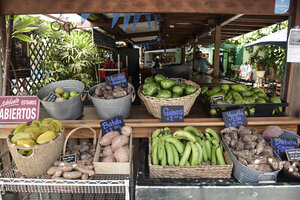A new way of looking at food castaways
Instead of cherry-picking through only the parts that are 'good,' consider choosing as much of the whole, intact produce, as can be found, as close to how it is found in nature as possible, writes a food advocate.

A produce stand inside El Departamento de la Comida farmers market and organic restaurant that sells locally grown produce in San Juan, Puerto Rico.
Carlos Giusti/AP/File
It’s no secret that Americans waste about 40 percent of the food supply, and by “food,” data studies are not including such delicacies as vegetable peels, fish bones, fallen fruit, and wild weeds.
“Reducing food losses by just 15 percent would be enough food to feed more than 25 million Americans every year at a time when one in six Americans lack a secure supply of food to their tables,” according to Dana Gunders, Senior Scientist at the Natural Resources Defense Council, in a groundbreaking 2012 report. Furthermore, wasted food is now the largest component in municipal landfills creating 30 billion tons of waste, breaking down to produce methane gas which contributes to climate change.
Numerous grassroots organizations have sprung up to begin to address the systemic challenges; massive efforts include redistributing unused food to people who need it. Local and home composting is on the rise.
However, the very core of the problem and the largest component of food waste is at the consumer level, which means the food wasted every day when each person buys, uses, and throws away food, based on how we live and what we value. Modern cultural values about what food is good and what is bad teach us:
Good: unblemished, symmetrical, glossy, fresh, firm
Bad: wilted, ugly, tough, unwanted, expired, bolted, a bug hole…..a little dirt
Yet, the castaway peels of a vegetable can contain most of the flavor and nutrition of the plant. Similarly, bones and cartilage extracted broths are brimming with umami, the essence of deliciousness. Brans left over from processed flour are toasty and nutty plus high in vitamins, fiber, and minerals. Wilted, no longer perky herbs and lettuces do not fit the current expectation of cosmetic perfection.
A weed is simply a plant that is not expected and not desired in the place that it is growing. In fact, many ordinary garden weeds such as chickweed, purslane, or dandelion greens are gourmet delicacies respected in other cultures and in ancestral practices, not to mention their proven nutritive value.
Instead of cherry-picking through only the parts that are “good,” consider choosing as much of the whole, intact produce, as can be found, as close to how it is found in nature, as is possible.
For example, the cauliflower or broccoli in the grocery store is, in its natural state, only the small flowerhead of a massive plant. Some stores are beginning to offer Brussels sprouts on the club-like stem they are attached to or cauliflower heads wrapped in their delicious leaves. Each part of the whole can then be enjoyed in a different dish for multiple meals. Start cooking with the whole fish, or ask your fishmonger to fillet and pack up the rest of the fish as well. The bones can be fried up as crunchy chips, just as they are served in Japanese bars. Apple cores and banana peels are also enjoyed in other cultures.
Indeed, ancient cultures have always ingeniously preserved the bounty of nature, depending on the skills of frugality and practicality to survive. We don’t have to invent how to use food with less waste—We just need to reconnect with nature and traditions that we came from and that support our communities.
It doesn’t take a lot of money to make an impact. The next time you get ready to toss some food in the trash or look disapprovingly at the wilted herbs in the bottom of the vegetable bin, pause. Look at the produce with a new respect and a creative eye for possibilities. If you still decide to throw it out, go right ahead, but at the same time realize that you have made a cultural choice about its value.
Tama Matsuoka Wong runs an innovative wild food business in the New York City area. She is the author of Foraged Flavor, a James Beard nominated cookbook field guide and, more recently, Scraps, Wilt and Weeds: Turning Wasted Food into Plenty with Chef Mads Refslund, a founder of Nordic restaurant NOMA.
This story originally appeared on Food Tank.

